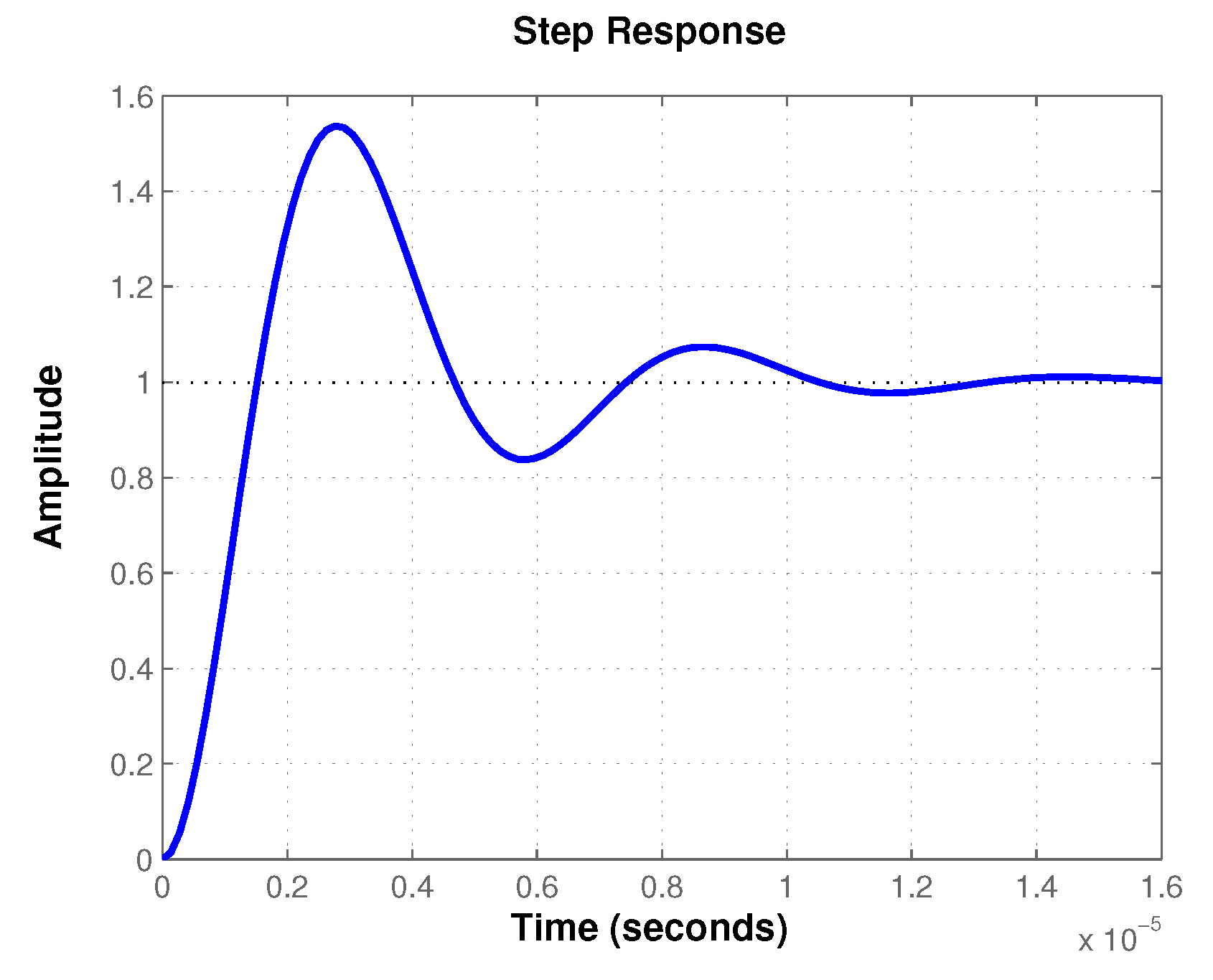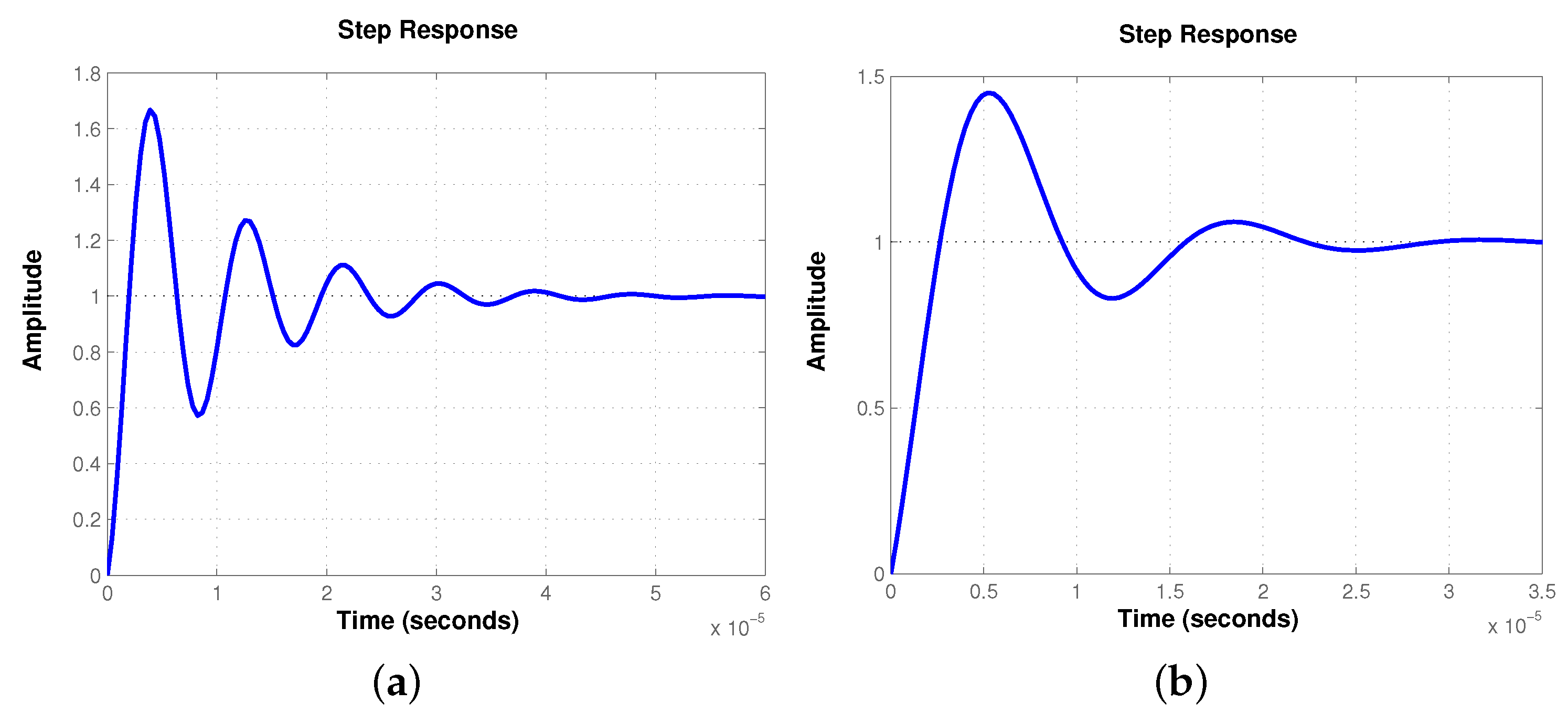1. Introduction
A power converter is a device that transforms the power supply characteristics into the ones required by a particular machine; DC–DC conversion is one of the most known applications [
1]. Research into DC–DC converters involves plenty of techniques proposed to improve performance [
2], efficiency [
3,
4] and modeling [
5] or to reduce conduction losses [
6], to mention a few.
Different control strategies have been proposed to enhance performance of DC–DC converters, ranging from the widely used Proportional-Integral and Proportional-Integral-Derivative controllers [
7,
8,
9], sliding mode control [
10], passivity-based control [
11], fuzzy logic controllers [
12,
13] or poles placement [
14], for instance.
In the last decade, control strategies have been explored, redesigned and adapted from the fractional calculus perspective, mainly seeking to improve the modeling accuracy and dynamic response. The main reasons behind using fractional calculus can be summarized as follows [
15,
16,
17]:
Lower order derivatives implies lower (reduction) levels of noise.
Robustness against parameters variations.
Better description of systems due to an extra degree of freedom (the fractional order).
Fits better the frequency behavior of some systems.
Fractional relations are realizable through ladder, trees or fractal arrangements of traditional electronic elements.
Good description of long-term memory effects, non-locality and fractal properties of systems.
Exact (good) approximation of systems with lumped (distributed) parameters.
Flexibility to approximate systems with large dimensional nature.
Many remarkable results, reporting the synthesis of non-integer order controllers for power converters, have shown the effectiveness of fractional calculus in Control Theory. In [
18], the non-ideal model of a DC–DC converter is controlled through an Internal Model Control strategy, which encapsulates the model of the plant within the controller, resulting in a structure resembling a PID with an extra lag network. The fractional-order controller improved the steady state performance. In [
19], a fractional-order PI controller is combined with fuzzy-logic precompensators to control a Buck converter via capacitor current. The combination improved the system disturbance-rejection capability and reference tracking performance. In [
20], a type-II fuzzy PID controller is proposed to handle uncertainties and external disturbances in a DC–DC converter connected to a microgrid. It minimized the instability effects in the converter, caused by the constant power loads of the microgrid. To improve the performance with respect to the varying parameters, an optimization algorithm for tuning the controller coefficients was proposed as well. A fractional-order back–stepping sliding mode controller was suggested in [
21]. The controller showed robustness regulating voltage of DC–DC converters in presences of uncertainties, unmodeled dynamics and non-linear loads. Moreover, it improved the capability of perturbation rejection and reduced the steady-state error. In a similar approach, an adaptive fractional-order sliding mode control was designed for current tracking for a DC–DC converter in [
22]. The adaptation rules were based on state observers and Lyapunov functions. Good transient response and robustness were the most important improvements. In [
23], a fractional-order PID controller was suggested to stabilize a DC-bus voltage of a ultra-capacitor hybrid energy system. An optimization algorithm was suggested to tune the controller parameters. The steady-state response showed higher performance and better steady-state properties. In [
24], a fractional-order PID controller was used to regulate the output voltage of a DC–DC converter in a photovoltaic (PV) system. The integration of incremental conductance method, maximum power point tracking and root locus technique was suggested to compute the controller parameters. This combination resulted in fast dynamics and high tracking accuracy under severe climate variations.
The above reviewed results showed that fractional-order controllers successfully achieved the control objectives and outperformed integer-order ones, yet they present two main drawbacks. On one hand, the controllers were designed by using one of the following definitions of the integro-differential operator: Grünwald–Letnikov, Riemann–Liouville or Caputo [
25,
26,
27], which increase the computational and implementation complexity. On the other hand, the parameters of controllers were obtained by either bee swarm, ant colony, bat, flower pollination, Nelder–Mead or teacher-learning optimization algorithms, which required the control strategy to be adapted to them, increasing the computational complexity.
In this paper, a simpler procedure to approximate a fractional-order PID controller to regulate the output voltage of a DC–DC Buck converter is explored. The non-integer approach is suggested due to fractional calculus have demonstrated accuracy in modeling real systems/phenomena and robustness against parameter variations. It is proposed to approximate the controller through a method that employs a frequency approach, the result of which is a controller that exhibits a flat phase response in a band-limited frequency spectrum. The proposed method takes into consideration both robustness and desired closed-loop characteristics, keeping the tuning process simple. It is shown that the resulting structure of the controller allows obtaining its representation in the time domain, which makes it easier to analyze its effects in transient and permanent regimes.
The paper is organized as follows:
Section 2 provides with the necessary preliminaries on DC–DC buck converter, i.e., its basic operation and the model description are provided. The method to be used to approximate the fractional-order PID controller is given in this section as well. In
Section 3 the synthesis of the fractional-order PID controller is described step by step. The tuning process of the fractional-order PID controller and the numerical results are also provided in this section. A comparison of performance and robust stability of typical PID controllers vs the fractional-order PID controller is addressed in this section as well. In
Section 4 the proposal for the possible realization of the fractional-order PID controller is described. Discussion and conclusions on the presented numerical results are provided in
Section 5 and
Section 6, respectively.
4. Proposal for Practical Realization of Fractional-Order PID Controller
A non-integer rational transfer function (RTF) can include fractional integral and derivative terms, which can be positive or negative [
39]. Practical implementation of RTF in a physical test–bed requires initially those terms to be approximated as a rational function of two integer–order polynomials within a desired frequency band. The methods developed to perform this approximation can be divided in (a) continue fractional expansion (CFE) and (b) interpolation techniques [
40]. For
, one can find the Carlson’s, the Matsuda’s and CRONE methods, among others. For
, one can find the Outsaloup’s, the refined Outsaloup’s, the Chareff’s methods and the technique recently reported in [
41]. Once the approximation process has been performed, the synthesis of the RTF can be obtained. This is generally performed by using either: (a) continue fractional expansion (also known as the ladder or paralleled form), (b) partial fractional expansion (also known as the tree fractance or cascaded parallel) or (c) a combination of both. After processing the approximation and synthesis, the electrical circuit can be obtained. To this end, there are two main approaches, analog and digital [
40]. The first one uses resistors, capacitors and operational amplifiers (OPAM), and the second employs FPGA boards.
In this paper, an analog realization is illustrated. By substituting
,
and
in (
9) and solving, the fractional-order PID controller one can obtain,
For the approximation stage, the toolbox
ninteger was used [
42]. The process to obtain the fractional PID approximation is shown in
Appendix A. The obtained transfer function after the MATLAB function residue execution [
43] is rewritten as follows:
The process to obtain the fractional-order PID synthesis is described in
Appendix B. The analog equivalence of (
17) is given on basic OPAM configurations (adder, integral, gain), and it is shown in
Figure 12. The section on top corresponds to the first fractional integral equivalent (left to right), the section in the middle corresponds to the second fractional integral equivalent (left to right), the bottom one relies to the gain, and the right section (red) refers to the adding points. Parameters of
Figure 12 are given in
Table 4.
By looking
Table 4, it can be noticed the particular value of the capacitor, which is high compared to the usual values given in mili or micro Farads. Nowadays, due to the development of super–capacitance technology, it is easy to find and available in the market [
44].
5. Discussion
This paper addresses the synthesis and tuning of the approximation of a fractional-order PID controller. Fractional-order approach is used due to it has been proven that controllers of non-integer order outperformed integer–order ones. However, the fractional integro–differential operator is described by either the Grünwald–Letnikov, Riemann–Liouville or Caputo definition, combined with different optimization algorithms to approximate the parameters of the controller. This results in an increase of computational and implementation complexity, which are the main drawbacks of that proposal.
The design process of the controller suggested in this paper considers a frequency domain approach. The approximation is achieved through biquadratic modules with flat phase response, which is used to generate the iso–damping characteristic to bear gain variations. The controller design takes into consideration both robustness and desired closed-loop characteristics, keeping the tuning process simple.
The resulting approximation of fractional-order PID controller produces a notable response with very fast speed of regulation. A comparison with integer–order PID controllers, one designed in frequency domain to meet the same gain and phase margins and the other to ensure stability of the closed-loop system, allowed to determine qualitatively the superiority of the suggested approach, since settling time in the closed-loop system with the fractional-order PID controller is a third and the half the time needed to settle the control variable with the typical PID ones.
On the other hand, the robust stability analysis allowed to determine that the three PID controllers have similar robust stability margins around the frequency band of interest center at rad/s. The minimum stability margins were at the peaks for the fractional-order PID controller and the 1st option of typical PID controller, while for the 2nd option of PID controller.
6. Conclusions
In this paper, a non-integer PID controller is suggested to regulate voltage in a DC–DC Buck converter. A method with frequency design approach was used to synthesize the controller. The resulting fractional-order PID controller approximation successfully achieved the control objective. The time domain structure of the non-integer PID controller resembles to a proportional controller. It was quantitatively shown that the fractional-order PID controller approximation produces an acceptable response, i.e., the steady–state error can be neglected due to its magnitude, but the time to reach the reference signal is much smaller than the one produced by typical PID controllers. This is, without hesitation the most remarkable result of this paper.
As future direction of this work, two possibilities are contemplated: the first direction is to consider two nested loops in the design of the controller, i.e., voltage and current, looking to simplify the design. Taking advantage of this approach, instantaneous transient response and DC shift of the output voltage for step changes in the load current, when using fractional-order controllers, can be investigated. Second possible direction is to explore the fast response capability of the system, introduced by the fractional-order controller, in other power converters such as the Boost configuration, whose right half–plane zero results in tighter frequency restrictions.






















